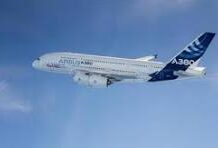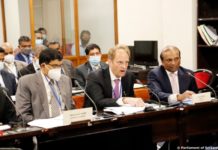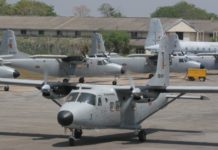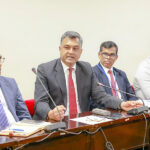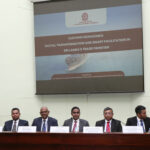By: Capt Gihan A. Fernando
On the evening of Sept 23, 1999, Qantas Flight QF1 was approaching to land at Don Muang International Airport in Bangkok, Thailand. The nine-year-old Boeing 747-400, registered VH-OJH and named City of Darwin, was carrying 391 passengers and 19 crew. It was en route from Sydney, Australia to London on the first leg of the so called ‘Kangaroo Route’.
That evening there were scattered thunder showers over Bangkok, which was quite common at that time of the year. The flight was uneventful and routine until the top of descent (‘TOD’) was reached. On the flight-deck that rainy night was a 49-year-old Captain with 15,881 hours of experience, a 36-year-old First Officer (F/O) with 8,973 hours of flying time, and a 35-year-old, 6,685-hour Second Officer (S/O). Also seated on the flight-deck was the latter pilot’s wife. If a crew member’s wife or partner was travelling as a passenger, it was not unusual in those pre-9/11 times for the captain to invite her to occupy the extra observer’s seat, or ‘jump seat’.
During the approach the aircraft was being flown by the F/O under the supervision of the captain, who was a company-designated Base Training Instructor (a trainer in take offs and landings for pilots). The crew did a thorough briefing which included the expected weather and visibility conditions in Bangkok. In aviation meteorology, good visibility is normally reported as being10km (kilometres) or more. On this occasion the visibility was reported by the ATIS (Automatic Terminal Information Service) as 7km in rain. In fact the F/O suggested that if the visibility was unacceptable, they should go around (abort the landing), climb away from proximity to the ground, and enter a holding pattern somewhere in the clear until it was safe to attempt a second approach and landing. To this the captain remarked that 7km visibility was not too bad and acceptable as it was only due to showers of rain.
However, when QF1 was on its final approach for Runway 21 Left the intensity of rain at the airport increased and visibility began dropping further, down to 4km. It was observed by then that the rain clouds were directly above the airport. At this point the captain suggested that automatic brakes (autobrakes) were selected to a higher no. 3 setting to compensate for a wet runway and the possible chance of skidding and aquaplaning. The aircraft’s anti-skid brake system would provide for safer stopping.
The visibility then went down to a mere 1,500 meters. Another Qantas flight (QF15) approaching the same runway just ahead of QF1 decided to go around. Unfortunately, that aircraft was speaking with the air traffic control tower on their radio frequency and could not be monitored by QF1 which was on the different ‘approach’ radio frequency.
Had the QF1 crew heard their own company aircraft discontinuing its landing and initiating a go-around, there is no doubt that they would have been mentally prepared for what to expect closer to the airport. When going around the pilot is expected to announce that decision to the control tower. To operate safely, pilots of today rely on their hearing perhaps to a greater degree than visual cues, to form a mental picture by listening out for other aircraft operators who all work on a common radio frequency. This enhances their knowledge of what is going on around them and is commonly known as ‘situational awareness’.
As per company-dictated procedures the F/O intended to use partial flaps ‘25’ for landing, and idle reverse thrust after landing. A higher ‘full’ flap setting would allow the aircraft to touchdown at a lower speed; and that, more than idle reverse thrust, would have allowed the aircraft to decelerate quickly. That would have been more appropriate for a wet runway.
Soon they spotted the lead-in approach lights to the runway, and the lights at the runway threshold. These lights were visible through the moderate rain which was not a deterrent to the crew visually orientating themselves, with wings level and a continuous descent in the final approach. The remainder of the runway lights were, however, obscured by the heavy rain over the runway.
Unfortunately, the F/O flattened out his descent in the rain and floated beyond his projected touchdown point (1,000ft from the threshold), so the captain had to remind him to keep on descending and get the aircraft on the ground quickly. As a matter of interest a ballpark rate of descent that pilots use to maintain an ideal 3-degree glide path is half the ground speed indicated by the GPS plus a zero, in feet per minute. For example, if the GPS-indicated ground speed was 160 knots, the pilot should strive to keep a rate of descent of about half of 160, that is 80, plus a ‘0’: 800 feet per minute. A rate of descent less than that will cause the aircraft to ‘float’ while using up valuable ‘real estate’ ahead. As an old aviation adage goes, ‘Runway behind you is useless. Runway ahead is priceless.’
The approach speed was a few knots faster but within limits. While the captain was aware that the Boeing 747 floated further in than the normal 1000 feet from the threshold, it was still within company tolerance limits. Hence, the captain increased the autobrakes setting to no. ’4’ without telling the rest of the crew. The heavy rain in the middle of the runway, prevented him from seeing the lights at the end of the runway, so he was unsure of their position relative to the length of the runway. Therefore he did the next best thing and ordered a go-around at low level. The standard procedure was for the F/O, who was flying the aircraft, to press the ‘Go Around’ buttons on the throttles. When either or both buttons are pressed the aircraft goes into the go -around mode: engine power increases automatically, the autobrakes switch off, and the Flight Director System provides the pilot with a precise nose-up attitude to fly. This manoeuvre is regularly practiced in the flight simulator, under supervision of an instructor. However, in this instance, for some reason the F/O increased the throttles manually without pressing the go-around buttons (using his index and the middle fingers). Consequently, the aircraft continued to descend due to its momentum and the wheels touched down on the runway softly.
By now they had passed the patch of intense rain at the centre of the runway and could see the lights at the end of the runway. The captain made a judgement call, without announcing to the rest of the crew, and closed the throttles by placing his right hand over the F/O’s left hand which was already controlling the throttles. In the process he inadvertently failed to close (throttle back) the number one (left outer) engine which was still operating at high thrust. As a result the automatic spoilers (air brakes), although armed, did not deploy as it did not satisfy auto-spoiler computer logic which demanded that all engines must be at idle power with the aircraft on ground for the spoilers to ‘pop up’. As the name implies, when the aircraft has touched down the spoilers ‘spoil’ the lift generated by the wings and forces the aircraft to stay firmly on its wheels to facilitate effective braking. The auto spoilers were eventually deployed only after the F/O pulled the no. 1 throttle back to idle power. The autobrakes also dropped off to ‘disarm’ position as one thrust lever was still at full thrust for over 3 seconds with the aircraft ‘on ground’, yet nobody on the flight-deck noticed it.
Usually, once a decision is made to go around and climb away from the ground, the flight crew are expected to stick to the plan without attempting to reverse their decision, for example attempting to land again. The captain being a flight instructor who teaches take-offs and landings decided to carry this out while accepting the risks. His unilateral actions obviously caused confusion on the flight-deck. At that point no-one knew who was in control of the aircraft. The standard aviation practice, from the pilots’ fledgling days, would have been that the instructors and captains brief the trainee or F/O that if they take over, they will announce loudly: “I have control”. In turn the trainee or First Officer must say, “you have control” so that there is no ambiguity. If appropriate to give back control to the other pilot, the instructor/captain must announce again loudly, “You have control”, and the other should again acknowledge by saying, “I have control”.
In this instance did the captain quietly interfere and not announce to avoid embarrassment to the F/O as the second officer’s wife was present in the flight-deck? We don’t know. But I have seen that happen. The Australian accident investigators, in their final report say that her presence did not affect the outcome of the accident. That is true. This aspect is purely the point of view of the writer who was a trained Human Factors Facilitator for a Far Eastern carrier.
Back at Bangkok … realising the urgency to slow down, both pilots were frantically braking using the manual brakes on the rudder pedals to bring the aircraft to a stop. As in most jet aircraft, there were four other stopping devices installed in the four engines, known as thrust reverses, which are effective at high speed. In their confusion the two pilots forgot to use them. The third pilot (second officer) didn’t remind the other two operating pilots either. (The roar of engine noise that passengers hear immediately after landing is the deployment of reverse thrust.) The devices literally deflect the engine thrust forward and engine power increases to assist the spoilers and wheel brakes to bring the aircraft to a stop. The thrust reverse controls are on the forward part of the throttle levers themselves and could be moved in one smooth movement up and backwards through an idle detent, after the throttles are closed.

Thrust Reverse Control Levers

Thrust Reverses at work on a wet Runway
The official investigation conducted by the Australian Transport Safety Bureau (ATSB) deduced by analysing the Cockpit Voice Recorder (CVR) and the Flight Data Recorder (FDR) that in this case the runway surface was flooded resulting from the intense rain and produced a phenomenon referred to as ‘aquaplaning’ whereby a thin layer of water is trapped between the runway surface and the tyres, rendering the brakes less effective and increasing the likelihood of skidding. Aquaplaning could occur where the depth of water is as little as 3mm (1/8 of an inch). From 146 knots the huge Boeing 747 took four seconds to reduce its speed to 134 knots. Seventeen more seconds to reduce to 94 knots and it entered an area at the end of the runway known as the stop-way, then overran it at a speed of 88 knots on to a muddy patch of grass. At 79 knots the aircraft struck an Instrument Landing System (ILS) localiser antenna (on the extended centre line of the runway) which demolished the nose wheel and the right landing gear, while also damaging the aircraft’s public address (PA) system, before sliding on its nose to stop 220 metres beyond the end of the stop-way just before a perimeter road.

B747 Flight-deck showing the throttle quadrant (centre of photo)

Where the aircraft came to rest

The Runway and Stopway
An inspection of the aircraft soon after the crash confirmed that the spoilers had been deployed and flaps were selected to an intermediate position ‘25’ in keeping with company policy. However it was also confirmed that reverse thrust had not been used after the touchdown. No significant injuries to passengers and crew were reported. The subsequent precautionary passenger evacuation was affected by the unavailability of the PA system.
Investigators further observed that the aircraft had suffered substantial damage resulting from the overrun. The demolition of the nose and wing-mounted right-hand gear caused a wing to drop slightly to the right allowing the two engines on the right wing to contact the ground as the airplane slowed down. A complete examination of the aircraft showed that every system on the 747 was in good working order before the overrun.
Between 1970 and 1998, there had been 111 overruns of Western-built aircraft. In fact, the final accident investigation report observed that runway overruns were quite common in the industry for Western-built, high-capacity aircraft. Often, long and/or fast landings and wet runways were factors in these accidents.
Usually there is a chain of errors that leads to such an accident or incident:
- If the crew used a higher flap setting than the Qantas-recommended (preferred) setting of position ‘25’, they would have touched down at a lower speed and stopped quicker. Full landing flaps (‘30’) would have created aerodynamic drag and assisted in stopping.
- Their landing approach was faster than normal (within company limits).
- The aircraft floated passed the normal 1,000 foot touchdown point.
- If the crew took the adverse weather into consideration and briefed themselves to use full reverse thrust after touchdown that would have assisted the wheel braking action. (While the two nose wheels had no brakes, the 16 main wheels, on the four main landing gear assemblies, had brakes equipped with anti-skid systems.)
- The captain did not stick to the original plan of action to carry out a go-around, when unsure of their position on the runway.
- Reversing the go-around decision unilaterally by the captain without announcing to the rest of the crew resulted in confusion.
- When closing throttles one (no. 1) was inadvertently left at full power, leaving the aircraft’s computer logic in disarray.
- No proper procedure for taking over and handing over of control was used.
- The crew members forgot to use reverse thrust after touchdown.
The Australian investigators, who are not expected to apportion blame, declared, after analysing performance data, that if spoilers and full reverse thrust were used, they would have been able to stop within the limited landing distance available. There was no way they could not use reverse thrust and stop. Further investigation into the ‘cause behind the cause’, by applying thorough accident analysis, discovered that it was a systemic problem in Qantas Airways. Amongst other things, inadequate emphasis during simulator training on deviating from company-preferred Flap 25 and idle reverse, when necessary, on contaminated and wet runways. This was confirmed by the training department. Flap 25 and idle reverse was apparently introduced and accepted by Qantas as a cost-cutting exercise, and to reduce noise. The flight simulators were incapable of providing realistic wet/contaminated runway simulations. The written word for wet/contaminated runway operations in the training manuals were found ‘hidden’ under the cold weather operations section (ice and snow). Many crews including those involved in the accident were not aware of the extra precautions to be exercised on wet/contaminated runways recommended in the book. Usually, Qantas crews encountered ice and snow in Japan and Europe in their route network.
Qantas was fortunate that no-one was injured. It is rumoured that they spent more than the cost of a brand-new Boeing 747-400 to repair and put VH-OJH back in service, just to maintain its long-held record as ‘the safest airline in the world’ and not have a ‘hull loss’ on their hands.
Capt Gihan A Fernando
RCyAF/ SLAF/ Air Ceylon/ AirLanka/ SIA/ SriLankan Airlines
Former Crew Resource Management (CRM) Facilitator SIA
Former Member of the CAASL Accident Investigation Panel




